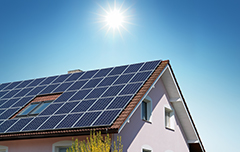
When you flip a switch to turn on a light, where does that energy come from? In a traditional power grid, electricity is generated at large power plants and then transmitted long distances. But now, individual homes and businesses with solar panels can generate some or all of their own power and even send energy into the rest of the grid. Modifying the grid so that power can flow in both directions depends on mathematics. With linear programming and operations research, engineers design efficient and reliable systems that account for constraints like the electricity demand at each location, the costs of solar installation and distribution, and the energy produced under different weather conditions. Similar mathematics helps create "microgrids" — small, local systems that can operate independent of the main grid.
A microgrid can keep the power flowing when a natural disaster knocks the main grid offline. For example, after Japan's devastating earthquake and tsunami in 2011, a microgrid powered in part by solar panels provided energy to a university and hospital in Sendai. A recently completed microgrid in Chicago's historically Black Bronzeville area — the US's first neighborhood-scale microgrid — demonstrates that such technology can increase the resilience of the communities most impacted by natural disasters. Researchers continue to develop their methods, often turning equations into computer simulations to visualize new microgrid designs. A related area of study is solar forecasting. Mathematical models that predict levels of sunlight days in advance will allow grid operators to better plan the flow of power from the Sun to your home, school, and community.





